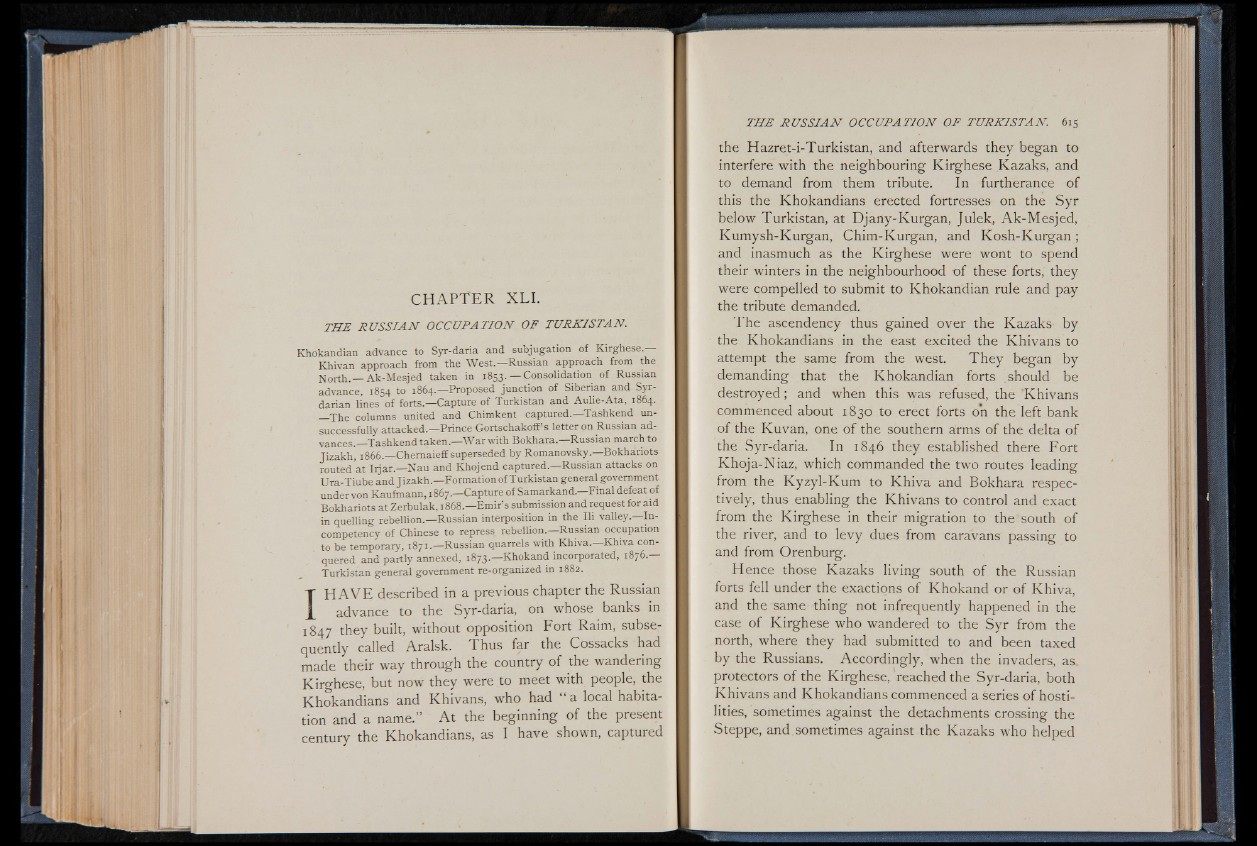
C H A P T E R X L I .
TH E R U S S IA N O C CU P A T IO N OF TU R K IS T A N .
Khokandian advance to Syr-daria and subjugation of Kirghese.
Khivan approach from the West.^R ussian approach from the
North. — Ak-Mesjed taken in 1853. — Consolidation of Russian
advance, 1854 to 1864.— Proposed junction of Siberian and Syr-
darian lines of forts.— Capture of Turkistan and Aulie-Ata, 1864.
The columns united and Chimkent captured.— Tashkend unsuccessfully
attackedfij-Prince Gortschakoff’s letter on Russian advances.—
Tashkend taken.— Wa r with Bokhara.— Russian march to
Jizakh, 1866.— Chemaieff superseded by Romanovsky.— Bokhariots
routed at Iija r.— Nau and Khojend captured.— Russian attacks on
Ura-Tiube and Jizakh.— Formation of Turkistan general government
under von Kaufmann, 1867.— Capture of Samarkand. Final defeat of
Bokhariots at Zerbulak, 1868.^ Em ir ’s submission and request for aid
in quelling rebellion.— Russian interposition in the Ili valley.— Incompetency
of Chinese to repress rebellion.— Russian occupation
to be temporary, 1871.— Russian quarrels with Khiva. Khiva conquered
and partly annexed, 1873-— Khokand incorporated, 1876,
Turkistan general government re-organized in 1882.
I H A V E described in a previous chapter the Russian
advance to the Syr-daria, on whose banks in
1847 they built, without opposition Fort Raim, subsequently
called Aralsk. Thus far the Cossacks had
made their way through the country of the wandering
Kirghese, but now they were to meet with people, the
Khokandians and Khivans, who had a local habitation
and a name.” A t the beginning of the present
century the Khokandians, as I have shown, captured
the Hazret-i-Turkistan, and afterwards they began to
interfere with the neighbouring Kirghese Kazaks, and
to demand from them tribute. In furtherance of
this the Khokandians erected fortresses on the Syr
below Turkistan, at Djany-Kurgan, Julek, Ak-Mesjed,
Kumysh-Kurgan, Chim-Kurgan, and Kosh-Kurgan ;
and inasmuch as the Kirghese were wont to spend
their winters in the neighbourhood o f these forts, they
were compelled to submit to Khokandian rule and pay
the tribute demanded.
The ascendency thus gained over the Kazaks- by
the Khokandians in the east excited the Khivans to
attempt the same from the west. They began by
demanding that the Khokandian forts should be
destroyed; and when this was refused, the 'Khivans
commenced about 1830 to erect forts on the left bank
of the Kuvan, one of the southern arms of the delta of
the Syr-daria. In 1846 they established there Fort
Khoja-Niaz, which commanded the two routes leading
from the Kyzyl-Kum to Khiva and Bokhara respectively,
thus enabling the Khivans to control and exact
from the Kirghese in their migration to the south of
the river, and to levy dues from caravans passing to
and from Orenburg.
Hence those Kazaks living south of the Russian
forts fell under the exactions of Khokand or of Khiva,
and the same thing not infrequently happened in the
case of Kirghese who wandered to the Syr from the
north, where they had submitted to and been taxed
by the Russians. Accordingly, when the invaders, aa
protectors of the Kirghese, 'reached the Syr-daria, both
Khivans and Khokandians commenced a series of hostilities,
sometimes against the detachments crossing the
Steppe, and, sometimes against the Kazaks who helped